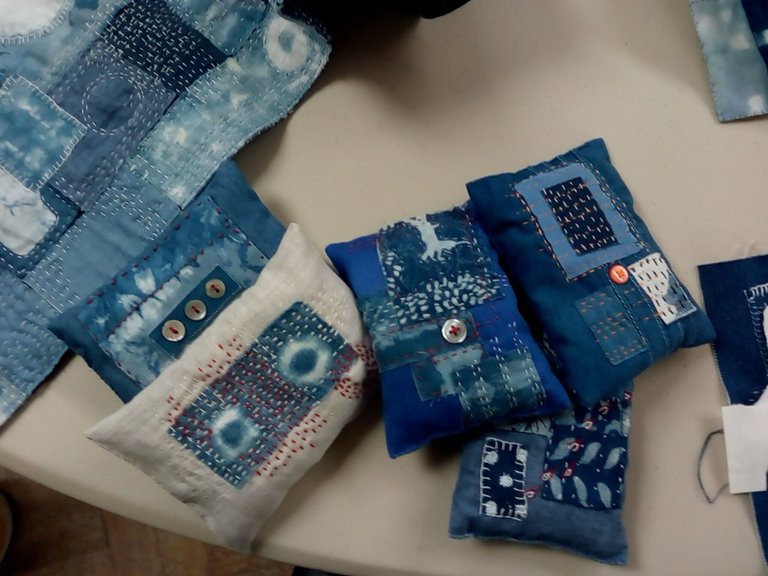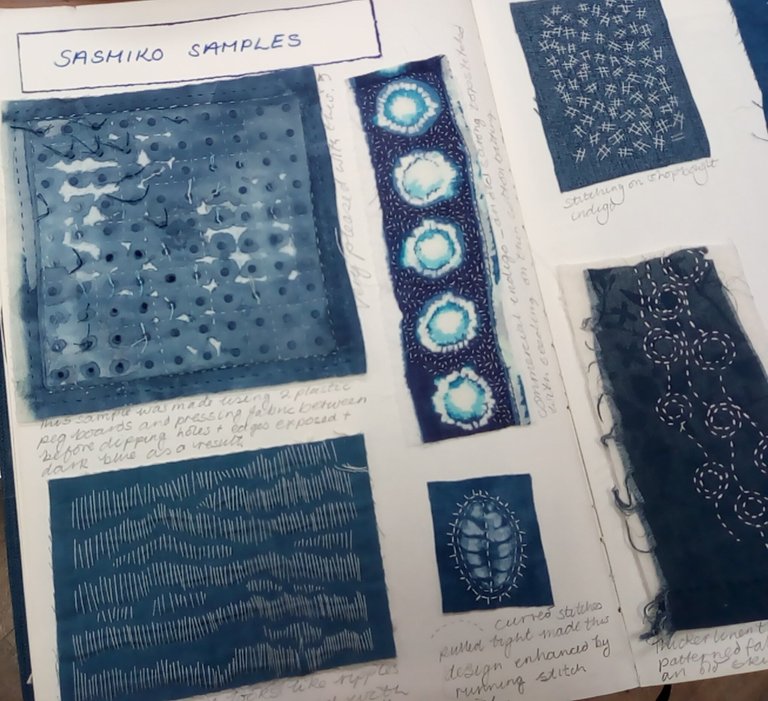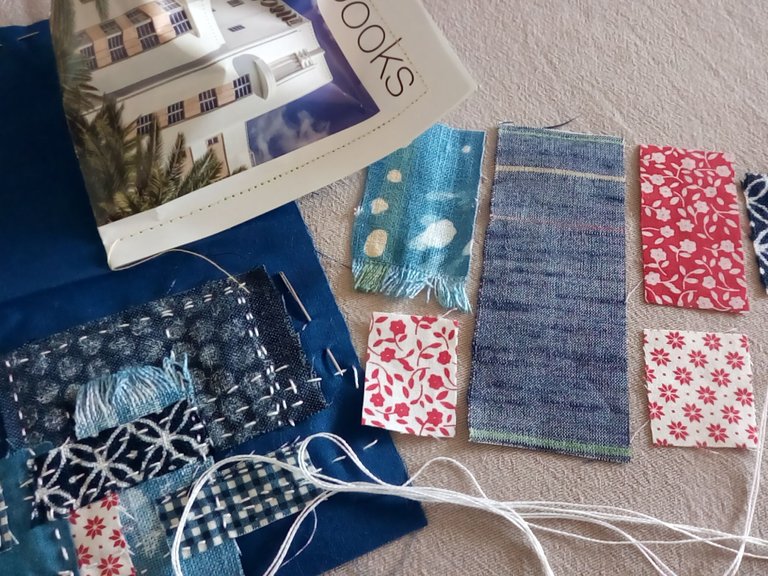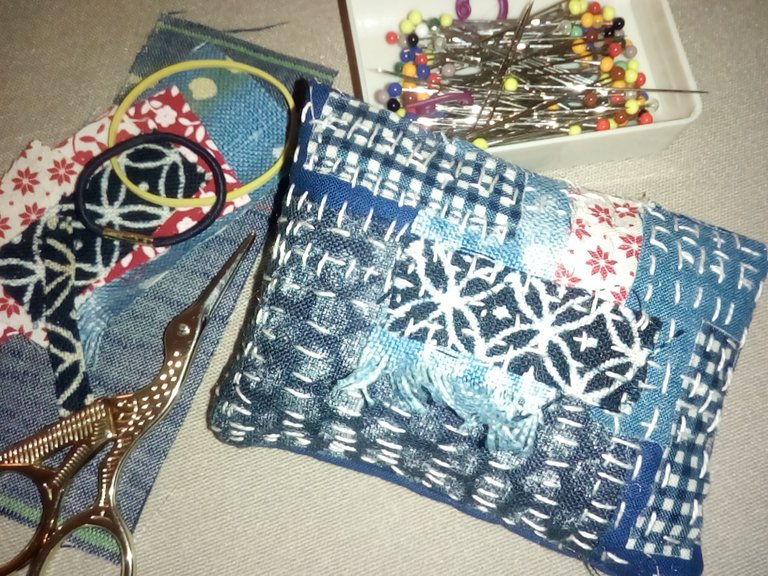#needleworkmonday | Learning Boro and Sashiko at My Sewing Group

Samples of Boro lavender bags made by Jane Stock, who gave a talk and workshop to my sewing group last Thursday.
My sewing group is getting back into the swing of things after a long closure due to the pandemic. We have twenty-four paid up members now, plus guests can visit and take part for a small fee. This month, Jane Stock, a member of the Visualise Textile Group, gave a short introduction to Boro and Sashiko and ran a workshop where we tried out some of the techniques by making a small lavender bag. All in two hours (plus time for a cup of tea and catching up with people).
Boro is more of a philosophy than a technique - the recycling of fabrics and the conservation of garments to prolong their life. When a garment becomes worn, small patches are applied with hand-stitching, sometimes patches over patches, as wear tends to be in the same place. Garments become the fabric of life and family history. Layers are also held together with stitching to create additional warmth.
Small running stitches are used for boro and traditionally done with white thread on indigo naturally dyed natural fibres - linen and hemp and, sometimes, cotton, for everyday wear. What I liked was that the patches are not hemmed, they are attached with raw edges, with the repeated lines of running stitch creating the strength and durability of the patch and preventing fraying.
I would describe Sashiko as an elaboration of Boro (perhaps @akipponn can help me here 😍) where the stitching becomes more elaborate and forms patterns rather than a criss-cross grid. I loved the sentiments behind the techniques: "favouring the modest", "acceptance of imperfection and incompletion" and "regret of waste".

Jane brought wonderful examples of her work and her sketchbooks were fascinating - beautiful works of art in their own right.
Jane describes her work like this:
I am particularly drawn to materials and textiles that have had a previous life and show signs of wear and repair. Different processes include hand stitch, printing and dyeing. Indigo is a favourite and I am fascinated by the various patterns and effects that can be produced. My hand stitching is all about mark making rather than precision or regularity. (Source)
The group that Jane belongs to, VISUALise, uses mentors to work with the textile artists in the group to develop their practice:
The role of the mentor is to engage each practitioner in a dialogue with themselves - to propose not to impose. Rather than a full-stop, finished work is to be seen more as a comma, a pause for breath and reflection within the dialogue. (Source)
That seemed like a great idea and benefit to me - the opportunity to reflect on your work and time and space to think about where you are going and how you are progressing. I wonder if we could develop such a thing through Needlework Monday?

After Jane's talk we had a chance to try some of the techniques ourselves. All the materials were provided including home-made paper-bags full of lavender! It was lovely, like the little goodie bags we used to get at children's parties. Here I've attached (artistically) arranged fabric scraps, prior to the repeated lines of stitching that creates the repair. Some of the indigo-dyed scraps on the right were re-cycled table cloths and napkins.
We'd been asked to bring a basic sewing kit: I forgot. But then, I was at a loss as I had given away all my embroidery things at the last meeting and wouldn't have had any suitable needles (large eye, sharp point). Luckily, I was able to liberate a needle from another member.
Although some of the fabric we were working with was re-cycled, some of it was new and I did find that a bit strange and, in a way, uncomfortable. These were ancient traditions, embedded in a way of life and made beautiful by necessity. Yet, here we were in Market Harborough, in one of the most affluent districts in England, using these techniques as decoration and entertainment.
I reconciled myself that I was learning new techniques that could be applied as they were intended - to repair and extend the life of garments. And actually, I had a repair that needed doing: a small hole had appeared in my leggings at about the point where the zip on my boots ends. I haven't decided whether to patch them in blue or red ... and I wondered about a woven patch on a knitted fabric. We'll see.

My finished lavender cushion. I like the way the stitching merges everything together as if it is one fabric. There is a small piece of wadding on the back which helps to stabilise the work and the stitching through several layers and the padding creates a fabric that feels very dense. In spite of my misgivings while I was making it, I like the finished article.
I think my piece is much more worked than the examples at the beginning. I liked Jane's comment about "My hand stitching is all about mark making rather than precision or regularity". That's true of me, too.


Three things newbies should do in their first week and, for most things, forever afterwards!

Awesome design and i love them all @shanibeer
Thank you 😍
!LUV
@shanibeer(2/5) gave you LUV. H-E tools | connect | <><
H-E tools | connect | <><
HiveBuzz.me NFT for Peace
Sashiko is on my to-do list.
I can see why, it is an interesting technique.
!LUV
@shanibeer(3/5) gave you LUV. H-E tools | connect | <><
H-E tools | connect | <><
HiveBuzz.me NFT for Peace
fantástico. y práctico @shanibeer
😍
!LUV
@shanibeer(4/5) gave you LUV. H-E tools | connect | <><
H-E tools | connect | <><
HiveBuzz.me NFT for Peace
Wow! I did not even know that there are different techniques for this. although I myself have a similar life credo: if a thing is of good quality and you love it, then it must be saved and given a new life! Your lavender pillow looks very harmonious. I love these pillows. this is truly a wonderful gift
Some communities have developed it to a fine art 😍.
I'm interested to see how I could use it with clothes.
this is really very interesting! After all, it is one thing to repair clothes and quite another to make it beautiful!
!LUV
@shanibeer(5/5) gave you LUV. H-E tools | connect | <><
H-E tools | connect | <><
HiveBuzz.me NFT for Peace
Looks cool and looks like you have to have patience.
!PIZZA
😍
!LUV
@shanibeer(1/5) gave you LUV. H-E tools | connect | <><
H-E tools | connect | <><
HiveBuzz.me NFT for Peace
PIZZA Holders sent $PIZZA tips in this post's comments:
@steem82868(5/10) tipped @shanibeer (x1)
dkid14 tipped shanibeer (x1)
Join us in Discord!
Learning every day, this is my family and my school, thank you for sharing your experience.
😍
!LUV
I knew a little about boron but I always keep an eye out for more research, it is an interesting ancient tradition and also very beautiful.
It is intriguing, and very interesting to learn about its history. 😍
Hi, I love this technique. Some time ago I read a post in this community, where I showed something like this only with jeans, it had a strange name different from the one you mention. Good vibes!
Thank-you 😍.
I have seen it used with jeans, too. I think I shall use it for my gardening jeans that need some repairs.
Sigh… as always I want to answer so many things at the same time :-)
First: I learned something. I have heard and read about sashiko before and always admired its aesthetic qualities (in my eyes the color scheme always is lovely) but I did not know Boro.
Second: I instantly recognise again how impatient and goal oriented I am… I am still not sure if I can either learn to accept this as a quality in myself or if I want to change/work on it. Because… my first thought while looking at your posts images was: so beautiful, I want it too. Second thought: needs too much time :-DDDD
But as I am strongly attached to some material things like porcelain cups or cute toys, books or cushions, the idea to be able to hold on to them over a long time because of repairing/mending techniques is reassuring.
I love the mentoring idea. Per chance I had Saturday a very intense (and long 8hous) coaching for the charity board I am in, which has constant problems with holding its members and fulfilling its own mission statements. I can imagine a similar very open approach (the approach was based on systems theory, not sure if it means the same in English as in German) to crafting… to ponder ones own goals, which may vary from „learning to sew pants“ to „trying to make more mistakes“ over „experience joy“ to „foster sustainability“ (just random ideas) and then develop a partnership to develop such areas…. But perhaps I am right now a bit brainwashed through over-coaching :-DDDD
ANd know back to sashiko: i adore the red/white fabric piece you included. The one different patch regarding colors, enhances the various shades of blue and off-white. For me its as if the blue/whites are a kind of frame for the red/white fabric.😍
I'm guessing the little pillow took me less than three hours to make. Maybe an hour at the meeting, an hour at home and then half an hour to machine and hand sew the closure after filling it with lavender. I guess a repair would be an hour or two depending on how big it was. Not bad, really, for us impatient people 😍.
Over-coaching: I am over-facilitated - a terrible condition!
We have a scheme called travelling books at the group: everyone has a book, decides a theme, decorates the cover and creates an introduction. Then, each month, the books are handed to another member in rotation, who takes it home, creates a piece of work in response to the theme and adds it to the book, together with a small explanation. At the end of the rotation (eighteen months last time - eighteen members took part), each person gets their book back filled with ideas and inspiration about their theme.
I am thinking about taking part in the next round, as I thought that discipline each month - to create a small piece in response to a theme - would be another way of developing practice.
I like the little piece of red, too - Jane's idea 😍.
Very well detailed thanks for sharing @shanibeer
😍
Hi @shanibeer,
Thank you for participating in the #teamuk curated tag. We have upvoted your quality content.
For more information visit our discord https://discord.gg/8CVx2Am
This was so intriguing! I love the look of this technique and the idea behind it. It reminds me of the patchwork @minismallholding did on her jeans, not sure if this is the same thing though. Your cushion looks amazing with that stitching. 😍
😍
Yes, this is the same concept as I've been doing on my jeans. I just do the patches on the back instead.
Awesome! I thought it was. Thanks for confirming ~
I have some jeans waiting for this technique, too.
Tag me if you share! 😁
Thank you 😍
It smells delicious, too. They would make quite nice presents ... maybe to pop inside those crochet bags you made 😍
Congratulations @shanibeer! You received a personal badge!
Wait until the end of Power Up Day to find out the size of your Power-Bee.
May the Hive Power be with you!
You can view your badges on your board and compare yourself to others in the Ranking
Check out the last post from @hivebuzz:
Congratulations @shanibeer! You received a personal badge!
Participate in the next Power Up Day and try to power-up more HIVE to get a bigger Power-Bee.
May the Hive Power be with you!
You can view your badges on your board and compare yourself to others in the Ranking
Check out the last post from @hivebuzz:
Ah that's very cool. I've been seeing more of the purposeful decorative type patchwork online lately but I didn't know a name for it. I like your sachet!
!BEER
View or trade
BEER.Hey @shanibeer, here is a little bit of
BEERfrom @phoenixwren for you. Enjoy it!Learn how to earn FREE BEER each day by staking your
BEER.This is interesting. Boro looks so much techniques. I bought a sewing machine recently. It's a portable handheld device, it use batteries !
Have a great day.
!LOLZ
!PIZZA
!PGM
100 PGM token to send 0.1 PGM three times per day
500 to send and receive 0.1 PGM five times per day
1000 to send and receive 0.1 PGM ten times per day
Discord
Support the curation account @ pgm-curator with a delegation 10 HP - 50 HP - 100 HP - 500 HP - 1000 HP
Get votes from @ pgm-curator by paying in PGM, here is a guide
Create a HIVE account with PGM from our discord server, here is a guide
I'm a bot, if you want a hand ask @ zottone444
lolztoken.com
They just work on so many levels.
Credit: reddit
@shanibeer, I sent you an $LOLZ on behalf of @steem82868
Use the !LOL or !LOLZ command to share a joke and an $LOLZ. (5/10)